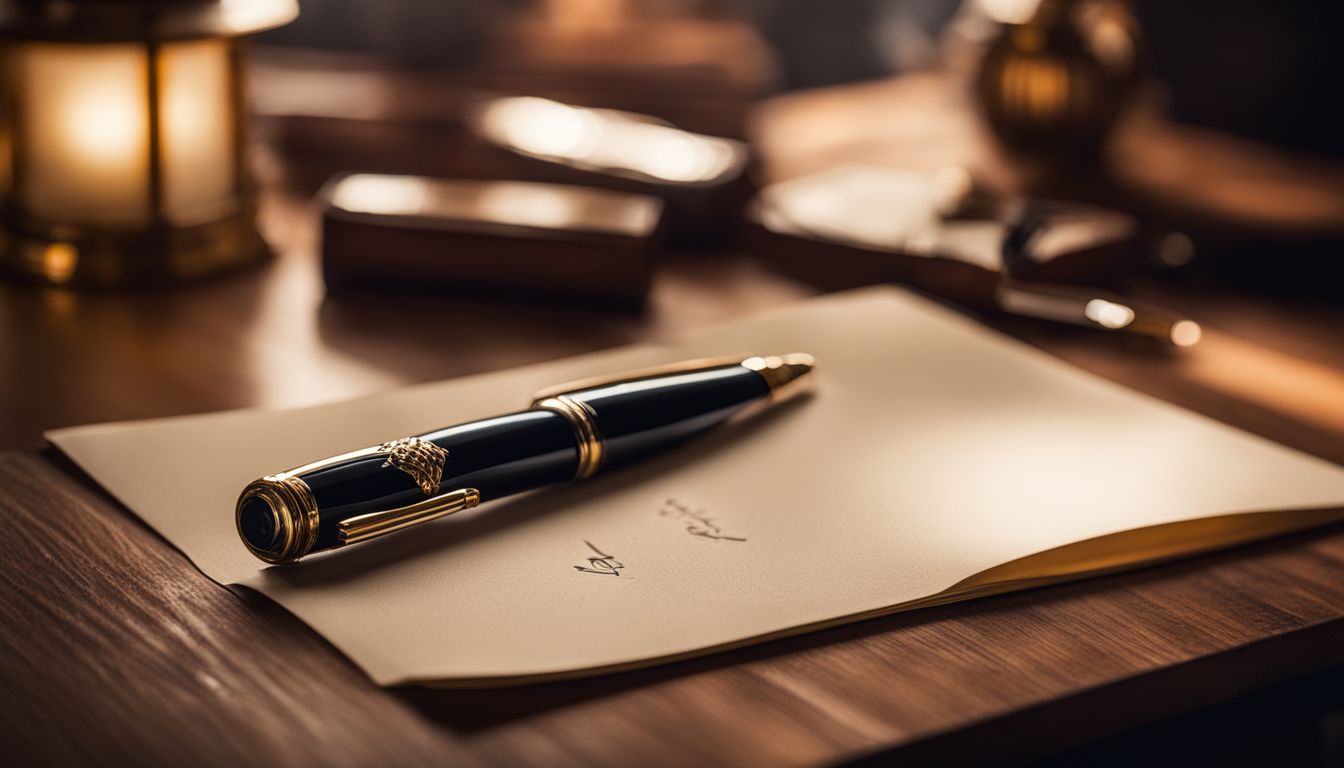Ever found yourself ready to jot down some thoughts, only for your trusty fountain pen to start skipping like a stone across water? Trust me, I understand that frustration. It’s disappointing when the tools we love don’t perform as expected.
But don’t worry—I’ve taken a deep dive into the details of nibs and inks to put together a straightforward guide designed to restore your pen to its former glory. Ready for smooth sailing and flawless writing? Let’s jump right in!
Key Takeaways
- Clean your fountain pen regularly by disassembling it and rinsing the nib with cool water.
- Flush your pen at least four times a year, or when changing ink colors, to avoid clogs and residue buildup.
- Refill your pen using an ink bottle and converter or by replacing the cartridge, making sure not to overfill it.
- Store your fountain pen upright to prevent ink leaks and ensure a consistent ink flow when writing.
- Avoid using Indian inks or Carbon inks because they can clog your fountain pen’s feed system.
Preparing a Fountain Pen for First Use

Getting your new fountain pen ready for its first spin is exciting. A few simple steps will ensure a smooth writing experience from the get-go.
- Before anything else, gather your fountain pen, some clean water, and a soft cloth.
- Start by taking your pen apart carefully—remove the cap, the barrel, and unscrew the nib section if possible.
- Grab an ink cartridge or converter; these are vital for storing fountain pen inks.
- Prime the pen by fitting the ink cartridge into the nib section with a gentle push until it clicks into place.
- Squeeze the cartridge softly to get the ink flow started; watch as it seeps into the nib.
- If you have a converter, dip the nib into a bottle of ink. Then, twist or pull on the converter to draw up ink.
- Run cool water through the nib section to flush out any factory residue or dust that might be lurking in there.
- Let cold water flow until it runs clear from the other side of the nib, ensuring all unwanted particles are gone.
- Dry off each part with a soft cloth—make sure they’re completely moisture – free before reassembling.
- Gently wipe down the nib to avoid any potential ink stains on your fingers or paper later on.
- Once everything’s back together and dry, give your pen a little test scribble on scrap paper to check for proper ink flow.
Regular Cleaning and Flushing of Your Fountain Pen
Regularly maintaining the cleanliness of your fountain pen is crucial to ensure its longevity and optimal performance. Learning how to properly clean and flush your pen will help prevent ink buildup and clogging, keeping it in top condition for writing.
How to Clean Your Fountain Pen
Taking care of my fountain pen keeps it writing smoothly. Regular cleaning prevents clogs and maintains the flow of ink. Here’s what I do to clean my fountain pen:
- Disassemble the pen by unscrewing the nib section from the barrel.
- Remove the cartridge or converter, if that’s what your pen uses.
- Rinse the nib and feed under cool tap water to wash away old ink.
- Fill a cup with warm water and let the nib soak for at least 2 hours.
- After soaking, gently shake out excess water from the nib.
- Use a soft, lint – free cloth to dry all parts completely.
- For a deeper clean, I use an ultrasonic cleaner with just water for about 5 minutes.
- Reassemble the pen once every part is dry.
Flushing the Fountain Pen with Cool, Clear Water
I know taking good care of my fountain pen means it’ll write smoothly for years. Flushing it with cool, clear water is an important step. Here’s how I do it:
- First, I disassemble my pen by gently twisting and pulling apart the nib section from the barrel.
- I remove any old ink cartridge or converter to avoid a mess.
- Under a tap, I run cool water through the nib section until the water runs clear.
- Sometimes, ink can be stubborn so I soak the nib in a cup of warm water for at least two hours; this helps loosen any dried ink.
- After soaking, I shake the nib section over a sink to get rid of excess water.
- With a clean, lint – free cloth, I carefully dry off the nib and feed.
- If there’s still some water inside, I let it air – dry before reassembling.
Refilling Your Fountain Pen
Refilling your fountain pen is a simple process that can be done using an ink bottle and converter or by changing the fountain pen cartridge. Both methods are easy to do and will keep your pen writing smoothly.
Keep reading for step-by-step instructions on how to refill your fountain pen with ink.
Refilling Using an Ink Bottle and Converter
To refill using an ink bottle and converter:
- Gently unscrew the barrel from the pen.
- Remove the converter unit from the barrel by carefully pulling it out.
- Attach the converter to the section of the pen where the nib is located.
- Dip the nib into an ink bottle.
- Operate the converter by twisting or pumping it to draw ink into its reservoir.
- Avoid overfilling to prevent leaks or excessive ink flow.
- Reassemble the pen and test for ink flow before use.
Changing a Fountain Pen Cartridge
When changing a fountain pen cartridge, follow these steps:
- Remove the empty cartridge by unscrewing or pulling it out, depending on the pen model.
- Dispose of the old cartridge properly to prevent spills and stains.
- Clean the inside of the pen where the cartridge sits using a soft cloth to ensure no residual ink remains.
- Insert the new cartridge into the pen, gently pushing until it clicks into place securely.
- Allow the pen to rest for a few minutes to enable proper ink flow before resuming use.
Tips for Storing Your Fountain Pen
Store your fountain pen upright to prevent ink leakage and nib drying. When flying with it, ensure the writing point is upright or remove the refill to avoid leaks. Flushing your pen at least four times a year is crucial to prevent nib clogging and drying.
Avoid storing the pen horizontally as it could cause ink leakage and affect the ink flow. Remember that proper storage helps maintain the longevity of your fountain pen and ensures consistent performance when you need it most.
Conclusion
Taking care of your fountain pen is crucial for a smooth writing experience. Remember to clean and flush it regularly using water and dish detergent. Refill the pen with care, whether using an ink bottle or changing a cartridge.
Store your pen properly to keep it in good condition. Enjoy the pleasure of writing with a well-cared-for fountain pen!
For a comprehensive guide on another essential writing tool, be sure to check out our complete overview of ballpoint pens.
FAQs
1. How do I keep my fountain pen in good shape?
To maintain your fountain pen, clean the nib regularly, use fresh ink from a cartridge or bottle, and store it properly when not in use.
2. What’s the right way to clean a fountain pen nib?
Gently rinse the nib with cool water until it runs clear—this keeps it writing smoothly and prevents clogs.
3. Can you explain how to change a cartridge in a fountain pen?
Sure! Twist open your pen, remove the old cartridge gently, then push in a new one until you feel it click into place.
4. Why is my fountain pen leaking, and how can I fix it?
Leaks might happen if the nib is damaged or the cartridge isn’t attached firmly; check these parts and replace them if needed for an easy fix.




Leave a Reply
You must be logged in to post a comment.